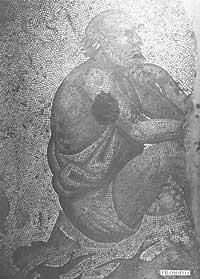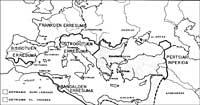Pure science. Situation and initiation
Its more than a thousand years of history (it is considered that the Roman Empire began with the construction of two fragments at the end of the death of Theodosius, that is, in 395, and its end, in defense against the Turks of Constantinopolis, Constantinus XI. the death of the emperor in 1453) presents three factors: the alteration of its geographical limits, the instability of its internal socio-political situation and the struggles of religious roots.
The territorial development of the Empire is but a large number of continuous expansion and shortening processes around a space. This space was formed by classical Greece and its former colonies in Asia Minor. This empire was guided centrally and acidly from Constantinopolis (Byzantium).
Within this empire there were a large number of peoples from different cultures and histories. Therefore, one of the main concerns of the empire was the desire to maintain political cohesion in a broad and different territory, and hence the harsh and centralized way of driving we have said.
In the hands of the emperor was all power and he was precisely the guarantor of imperial unity. Therefore, most of the revolts that occurred dreamed of the acquisition of the throne and over time thirty people managed to sit on it for more or less time.
In this unstable situation the structure was totally pyramidal and the tax burdens and military obligations were above all on the peasants. That is why, on many occasions, his life was worse than that of the servants of feudal Europe of the same time.
Alongside the political struggles there were continuous discussions and religious confrontations. The emperor's dependence on the Byzantine church and the fulfillment of the spiritual unity of his own empire often forced theological debates to reach the public. In the cultural sphere the powerful level of the Church ensured the continuity of Greek culture. The Byzantians were considered descendants of the Greeks and preserved the ancient ones known through transcriptions and collections. But their culture was totally isolated and closed, that is, without development.
Therefore, and in short words, the framework of the Byzantion is that of religious and military struggles in the west (foundations and crusades), the risk of invasions by the other parties (barbarians and Muslims) and continuous internal revolts. Not developing culture in this framework and therefore being fossilized is absolutely normal.
Science situation
Before studying the philosophy of Byzanzi, they had to learn the exact sciences of quodrivium. However, in the beginning, both mathematicians and astronomers, among whom the most prestigious are in the 5th century of Proklo and in that of Simplicius VI, only analyzed very well the works of Euclid and Aristotle. There is no work of creation. Filopon commented the Arithmetic of Nicholas; VI. The topography of Kosmas Indikopleustat, in the eighteenth century, is very modest and, moreover, the reading of Ptolemy's work is nothing more than a misreading.
The most fruitful result is therefore the construction of the Hagia Sophia church in Constantinopolis, one of the few functions that demonstrates great mathematical knowledge. The authors were Isidoro de Mileto and Antemio de Trallas. This building requires a very high architectural and mathematical level. In most cases, the high level, together with the great monuments, is accompanied by other more normal constructions. But in the case of Byzantium, a thorough investigation has not been conducted. What exists is from the 10th century and only indicates some hydraulic and automatic instruments inspired by the Heron of Alexandria.
VI. Apart from Stephen's work on arithmetic in 11th century Alexandria. In the twentieth century appeared a thinker named Mikel Pselo. In addition to politician, historian and philosopher, he wrote some commentaries on the Arithmetic of Diofante. He also dealt with theoretical music, astronomy, medicine and geometry. His comments include those related to geometry and, although not a work of creation, show a deep knowledge of the work of Euclid.
XII. In the 19th century Emperor Mikel initiated mathematical research to address some of the concerns raised by astronomy. In the following centuries the emperors of the Paleologist family followed the same path and obtained results of Greek and Arabic influence.
In the civilization of Byzantium, XII. At the end of the 20th century we must quote a name: Maximum Planudes. This researcher, commenting on Diofante, introduced the concept of zero in Byzantium and through Indian culture the first nine numbers, the numbering system we currently use.
XIII. In the 20th century we have to mention another name, Pakimeres. The tendency of this man was encyclopedic and wrote a work on the quadrivium, which would have a great influence. This is a compilation work in which you can find summaries of the first book of Diofante and the works of Euklides and Nikoma.
However, in short, together with Bréhie we can say of Byzantium: In the field of astronomy he does not leave the domain of Ptolemy and in mathematics of that of Euklides.
Natural sciences
Nothing was done about Byzantine botany. Zoologically, Timothy of Alexandria VI. At the beginning of the 20th century he wrote a great work. In fact, it has been made from data from ancient sources, and especially from Aristotle. It has very little new data and follows the mistakes that there were. Some references to this work are found in the work of Indikoplesutes and in some way initiate a tradition. It contains remains of applied zoology: beekeeping, dangerous animals, etc. VI. In the mid-twentieth century Justinian promoted the growth of cetaceans brought by two friars in the East. Finally, because the byzantiums were very good hunters, they wrote some works about certain animals (including the dog), but they are not very precise either.
Alchemy
Alchemy was not born in Byzantium. It seems that its further initial development occurred in Alexandria, arising from Greek, Egyptian, Jewish and Chaldean practices. Sacred Art IV. From the 20th century it became very important in Egypton and its surrounding villages, especially. Golden Age of Alchemy Alejandriana III. It extends from the nineteenth century to the beginning of V.

The alchemists of Alexandria, although they belonged to very different religions, had a high common illuminism, creating a certain relationship between them. One of the best known alchemists, Zosimo de Panapolis, IV. We have it in the early twentieth century; he lived in Alexandria and left many works. At the same time we have Ustio and Olympiodoro. However, the best known name is the Jewish Mary, with whom we have to mention the Coptic Cleopatra and Theosebia. Mary invented the Kerotakis ship. This method has reached us with the name of bath Mari.
In this first era of Alchemy its three themes or areas were defined: the first, the transmutation of metals or the search for philosophical stone to convert metals into gold or silver. The second, the panacea, a system to perpetuate human life forever. And the third, that of eternal happiness within God and union with the spirit of the world. As we can see, the alchemists mixed spiritualism with the topics we would include today in chemistry.
In this situation, VI. In the twentieth century it reached the Syrian alchemias, Arabs and biases. However, most of the stories about Byzantine alchemy go back to the 10th century and it is a field that most of the encyclopedic ones mentioned worked on. However, until the beginning of the Renaissance, Alchemy does not adopt, say, a more scientific attitude.
There is debate about the name of Alchemy. Some believe that the name of alchemy should be left behind from what the Arabs did and that the work of the Byzantians would be or chemeutical. The reason they defend is exclusively etymological, that is, in Arabic kimya means black people. But it must be recognized that, with names, what has then been known as alikimia was also cultivated in Byzantium. Along with him were obtained some discoveries that demand a technical level. The Greek fire, for example, used in the battle won by Constantinus IV to the Arabs in the year 678 and since then. This fire was of naphtha, resin or sulfur and projected with different appliances. At the same level we can place some pyrotechnic compositions. Finally, the alchemical properties of the rocks allowed a certain advance in the mineralogy.






